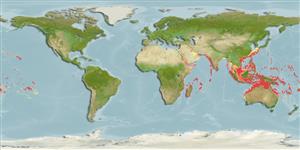分類 / Names
俗名 | 同種異名 | Catalog of Fishes(屬, 種) | ITIS | CoL | WoRMS | Cloffa
Teleostei >
Eupercaria/misc (Various families in series Eupercaria)
鱸形目 (Various families in series Eupercaria) >
Lethrinidae (Emperors or scavengers)
裸頰鯛科 (Emperors or scavengers) > Lethrininae
Etymology: Lethrinus: Greek, lethrinia, a fish pertaining to genus Pagellus.
More on author: Valenciennes.
Environment: milieu / climate zone / depth range / distribution range
生態學
海洋 礁區魚類; 非遷移的; 深度上下限 1 - 185 m (Ref. 9710). 熱帶; 33°N - 35°S, 33°E - 135°W
Indo-West Pacific: Red Sea and East Africa to Samoa and Polynesia, north to the Ryukyu Islands; south to Australia.
印度-西太平洋: 紅海而且東非到美屬薩摩亞, 北至琉球群島。
Length at first maturity / 大小 / 重量 / 年齡
Maturity: Lm ?, range 34 - ? cm
Max length : 100.0 cm TL 雄魚/尚未辨別雌雄; (Ref. 2295); common length : 70.0 cm TL 雄魚/尚未辨別雌雄; (Ref. 2295); 最大體重: 14.0 kg (Ref. 9710)
背棘 (總數): 10; 背的軟條 (總數): 9; 臀棘 3; 臀鰭軟條: 8. This species is distinguished by the following characters: body moderately slender, its depth 2.9-3.4 times in standard length; head length 1.1-1.3 times in body depth, 2.4-2.9 times in SL, dorsal profile near eye nearly straight or with small bump; snout length about 1.7-2.2 times in HL, measured without the lip the snout is 0.6-0.8 times in cheek height, its dorsal profile slightly concave, snout angle relative to upper jaw between 40° and 50°; interorbital space convex to flat; posterior nostril a longitudinal oblong opening, closer to orbit than anterior nostril; eye situated close to or not close to dorsal profile, its length 3.4-6.2 times in HL; cheek height 3 to 3.8 times in HL; lateral teeth in jaws conical; outer surface of maxilla smooth; D X, 9 with the 3rd or 4th dorsal-fin spine the longest, its length 2.4-2.8 times in body depth; A III,8 with the first soft ray usually the longest, its length almost equal to or slightly shorter than length of base of soft-rayed portion of anal fin and 1.3-1.7 times in length of entire anal-fin base; pectoral-fin rays 13; pelvic-fin membranes between rays closest to body with dense melanophores; cheek without scales; 46-48 lateral-line scales; 5 ½ scale rows between lateral line and base of middle dorsal-fin spines; usually 16-17 scale rows in transverse series between origin of anal fin and lateral line; 15 rows in lower series of scales around caudal peduncle; 6-9 scales in supratemporal patch; inner surface of pectoral-fin base without scales; posterior angle of operculum fully scaly. Colour of body grey, lighter ventrally, often with scattered irregular dark blotches; snout with wavy dark streaks, upper jaw, especially near corner of mouth sometimes edged behind with red (Ref. 114226).
可能大又吻部最長的龍占魚科魚類。 在臉部與鰭上的深紅色的外貌可能在大的求愛雄性中發育。 (參考文獻 1602) 體色是灰色, 變成腹部顏色較淡, 時常有分散的不規則的黑色斑塊。 吻部有波浪狀的深色條紋。 上頜, 尤其在嘴巴的角落的附近, 有時被有紅色邊緣。 非常類似 L. microdon, 但是更多的鱗片在側線上面與尾鰭分叉較深幼年時.(參考文獻 48635)
Largest and the longest-snouted lethrinid (Ref. 37816). Found in sandy coastal areas, lagoons, and reef slopes (Ref. 30573). Juveniles are found in shallow sandy areas. Often occurs in large schools. Adults deep along coastal slopes and drop-offs, usually solitary (Ref. 48635). Very active and swims fast (Ref. 90102). Feeds mainly on fish, crustaceans, and cephalopods. In Palau, it spawns throughout the year on the first few days of the lunar month along the edges of reefs. Large individuals often ciguatoxic in New Caledonia and possibly elsewhere in Oceania (Ref. 9775). Caught mostly with handline and traps, occasionally by trawls and gill nets (Ref. 68703). Ref. 48635 reports maximum depth of occurrence.
大的與吻部最長的龍占魚科魚類.(參考文獻 37816) 發現於沙的沿岸區域,潟湖與礁斜坡了。 (參考文獻 30573) 稚魚被發現於水淺的沙地區域。 時常在大群魚群中出現。 成魚沿著海岸的斜坡與海峭壁深處, 通常獨居性的.(參考文獻 48635) 主要吃魚,甲殼動物與頭足類動物。 在帛琉,它在陰曆月的幾天沿著礁的邊緣的第一個上產卵全年度。 大的個體時常在新加勒多尼亞的有西加毒的與可能地在大洋洲的別地方.(參考文獻 9775) 參考文獻 48635個報告發生的最大深度。
Life cycle and mating behavior
成熟度 | 繁殖 | 產卵場 | 卵 | 孕卵數 | 仔魚
Protogyny have yet to be confirmed for this species.印度-西太平洋: 紅海而且東非到美屬薩摩亞, 北至琉球群島。
Carpenter, K.E. and G.R. Allen, 1989. FAO Species Catalogue. Vol. 9. Emperor fishes and large-eye breams of the world (family Lethrinidae). An annotated and illustrated catalogue of lethrinid species known to date. FAO Fish. Synop. 125(9):118 p. Rome: FAO. (Ref. 2295)
人類使用
漁業: 商業性
工具
特別的報告
下載 XML
網路資源
Estimates based on models
Preferred temperature (Ref.
123201): 23.3 - 28.4, mean 27.1 °C (based on 1006 cells).
Phylogenetic diversity index (Ref.
82804): PD
50 = 0.5000 [Uniqueness, from 0.5 = low to 2.0 = high].
Bayesian length-weight: a=0.01585 (0.01372 - 0.01830), b=2.97 (2.93 - 3.01), in cm total length, based on LWR estimates for this species (Ref.
93245).
營養階層 (Ref.
69278): 4.0 ±0.4 se; based on diet studies.
回復力 (Ref.
120179): 低的, 最小族群倍增時間4.5 - 14 年 (K=0.06-0.25; tm=4.1-6; tmax=15).
Prior r = 0.28, 95% CL = 0.16 - 0.49, Based on 2 stock assessments.
Fishing Vulnerability (Ref.
59153): Moderate vulnerability (40 of 100).
Nutrients (Ref.
124155): Calcium = 27 [18, 42] mg/100g; Iron = 0.805 [0.519, 1.262] mg/100g; Protein = 20.2 [17.7, 22.4] %; Omega3 = 0.132 [0.091, 0.189] g/100g; Selenium = 62.4 [30.4, 109.4] μg/100g; VitaminA = 30.6 [7.4, 154.2] μg/100g; Zinc = 1.45 [1.06, 1.90] mg/100g (wet weight); based on
nutrient studies.
